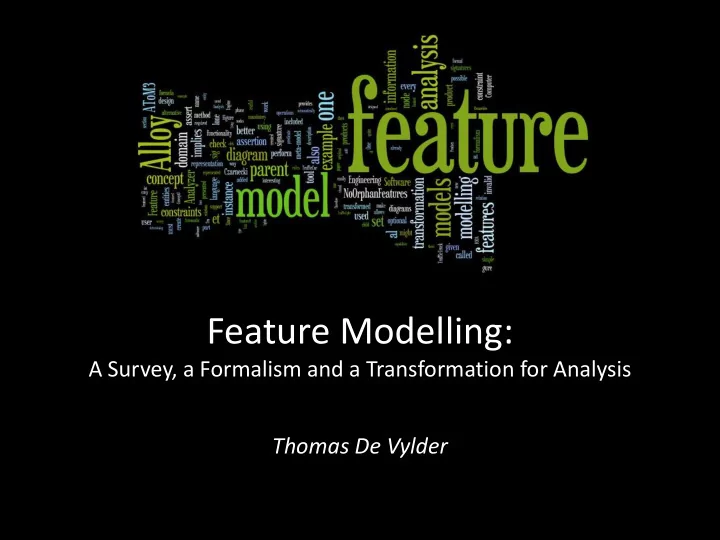

Feature Modelling: A Survey, a Formalism and a Transformation for Analysis Thomas De Vylder
Content Feature Modelling Origins Feature Modelling Notations & Definitions AToM³ Meta-Model Formal Analysis of Feature Models + Operations + Model Transformation To Alloy Beware Demo
Feature Modelling Origins
Feature Modelling Origins • First introduced in Feature-Oriented Domain Analysis (FODA) method* – FODA is the Domain Analysis component of Model Based Software Engineering (MBSE) – Feature modelling captures the commonalities and variabilities in terms of features of systems in a domain • Vigoriously used in the Software Product Line (SPL) community – SPL is identified by a unique and legal combination of features * Kang, K. C., Cohen, S. G., Hess, J. A., Novak, W. E., Peterson, A. S., November 1990. Feature-oriented domain analysis (foda) feasibility study. Tech. rep., Carnegie-Mellon University Software Engineering Institute.
Feature Modelling Notations & Definitions
Feature Modelling Notations & Definitions • Based on this diagram of a model:
Feature Modelling Notations & Definitions • Concept
Feature Modelling Notations & Definitions • Features
Feature Modelling Notations & Definitions • Mandatory Features
Feature Modelling Notations & Definitions • Optional Features
Feature Modelling Notations & Definitions • OR Features (at least one)
Feature Modelling Notations & Definitions • Alternative (XOR) Features (one and only one)
Feature Modelling Notations & Definitions • Sets (XOR, OR) with optional features – Can be normalized • Cross graph constraints can exist – “All TrafficCars with an automatic transmission must have a LogicUnit” – “All TrafficCars with a manual transmission may not have a LogicUnit”
AToM³ Meta-Model
AToM³* Meta-Model • Concept/Feature (no distinction!) – Name (must start with capital letter) – SemanticDescription – Rationale – StakeholdersAndClientPrograms – ExemplarSystems – Priority • Port (Inheritance: Optional/Mandatory) • Subset (Inheritance: XOR/OR) • Constraint – Name (must start with capital letter) – Constraint (textual relational language Alloy) • Comments – Content * De Lara, J., Vangheluwe, H., Posse, E., A. Vasudeva Murthy, I., Provost, M., Liang, W., 2002. AToM3 A Tool for Multi-formalism and Meta- Modelling. URL http://atom3.cs.mcgill.ca/index html
AToM³ Meta-Model
Formal Analysis of Feature Models
Formal Analysis of Feature Models • Which operations must be included?* – no consensus • Possible tasks: – Determine the satisfiability Is a product represented by the feature model? – Dead feature Can a product represented by the feature model have this feature? – Find a product – Obtain all products – ... * Benavides, D., Ruiz-Corts, A., Trinidad, P., Segura., S., 2006. A survey on the automated analyses of feature models. In: Jornadas de Ingeniera del Software y Bases de Datos (JISBD).
Formal Analysis of Feature Models • Problem: no analysis tools that run on my feature models • Solution: model transformation! • Transform to? – Alloy*: a textual modelling language based on first order relational logic. * Jackson, D., 2002. Alloy Analyzer website. URL http://alloy.mit.edu/
Formal Analysis of Feature Models • Alloy – some X – Signatures – no X – Fields – one X – Facts – lone X – Asserts – all x: X | formula – Predicates – some x: X | formula – no x: X | formula – one x: X | formula – lone x: X | formula
Formal Analysis of Feature Models • Model Transformation refers to refers to Target Transformation Source Meta-model Definition Meta-model conforms to conforms to executes reads outputs Source Target Transformation Model Model
Formal Analysis of Feature Models • Model Transformation TransformerFM 2Alloy.py Transformation
Formal Analysis of Feature Models • Model Transformation – metadata comments + module name – features/concepts signatures with same name – relations fields with constraints/facts – cross graph constraints facts • Extra: – comments to create structure – assertions to check for dead features – predicates/facts and runs for product finding and determining the satisfiability
Beware
Beware • Presentation ⊂ Paper – More background/detail -> read paper! – More mathematics -> read paper! – Extentions to feature models -> read paper! – Exact rules -> read paper! – Characteristics of transformation -> read paper! – …. -> read paper!
Beware • Wikipedia has other notations! – Everybody has their own notations (Czarnernecki, Kang, me, …) – I tried to be the same as Czarnernecki • Feature models are abstract – Do you want your entity of a car to have “the same” entity of an engine as the entity of the car of someone else? – Simulation/Real world requires more information
Demo
Recommend
More recommend